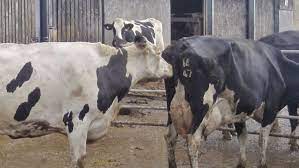The heat (oestrus) period is the time within the oestrous cycle when the female animal stands to be mounted and mated by the male. The oestrous cycle refers to the cycle from one period of heat to the other in the same female animal.
Heat (oestrus) detection becomes necessary when:
Animals are to be artificially inseminated.
There is need to keep accurate breeding records
Checking for absence of pregnancy after breeding.
Males have an inherent capability and are best detectors of females on heat. However, there are characteristic signs of oestrus for each species.
Read Also : Animal Sex Determination and Manipulation
Signs of Oestrus in Some Farm Animals
Table 3: Signs of Oestrus
| Species | Observable signs | ||||
| Swollen vulva | Mucous secretion | Behavior | Absence of male | Presence of male | |
| Sow | Yes | No | Restless, irritable, explorative, frequent urinations, vocal emissions | Immobility response to man | Stands to man |
| Ewe | No | NO | None | None | Stands to male |
| Cow | Sometimes | Sometimes | Restless, nervous, off feed herd mates | Stands for herd mates | Stands for either male or herd mates |
Heat Detection in Practice

In sows, intact boar can be introduced into a pen of females and observation made of those females the boar attempts to mount. Back pressure can also be applied on the suspected sow on heat and she could be immobile if on heat.
In ewes, vasectomized rams can be fitted with marking harnesses containing marking crayons. The raddled ram can be made to run with the ewe flock. Ewes on heat will stand to be mounted and marked.
In the cow, intact or vasectomized bull can be fitted with a chin-ball marker and introduced into a herd of cows. Cows on heat will stand to be mounted and marked.
In summary, heat detection is very important in livestock management especially where females are kept separate from the males. Knowing the signs of heat is therefore important for optimum reproduction.
Read Also: A Guide to Starting Your Own Banana Farm
